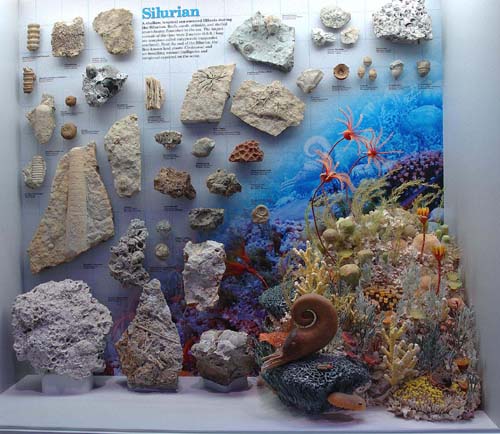
We based this reef on fossils from the Racine Dolomite at Thornton Quarry in Cook County, Illinois.
443 - 417 Million Years Ago — Silurian Period
A shallow, tropical sea covered Illinois (then south of the equator) during the Silurian. Reefs, corals, crinoids, and shelled invertebrates flourished in the sea. The largest animals of the time were 2-meter-long (6.5 ft.) sea scorpions called eurypterids. In the late Silurian, the first-known land plants (Cooksonia) and air-breathing animals (millipedes and scorpions) appeared. Ocean reefs occurred in a band 30 degrees to the north and south of the equator. This period marks the most widespread distribution of reefs in the history of North America.
A Middle Silurian Reef, 425 Million Years Ago
Reefs were located around the edges of shallow areas in the tropical sea.
They consisted of rigid, vertical mounds of coral colonies, stromatoporoid
sponges, and algae that were cemented together and could withstand strong wave action on the reef crests. Delicate
corals, bryozoans, and crinoids were in protected pockets and along the
sides of the reefs. Hidden in the tangle of branching organisms were
shelled animals—brachiopods, snails, clams, and trilobites.
They were eaten by predatory, squid-like cephalopods.
The reefs ranged from less than a meter (3.3 ft.) to several kilometers in diameter, and from less than 3 meters (about 10 ft.) to nearly 304 meters (about 1000 ft.) high.